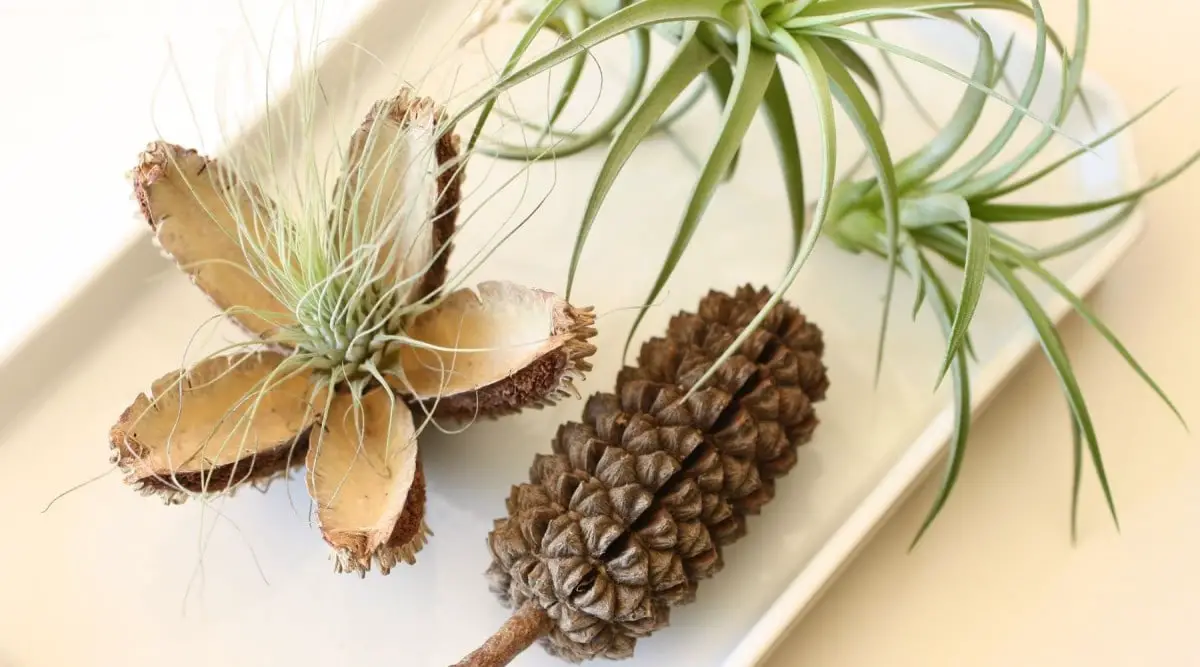
7 Best Places to Put Air Plants
Air plants are highly popular among plant lovers, especially those who want greens in their houses but don’t have much time to care for them. They’re very low-maintenance and come in various shapes, colors, and textures.
This post may contain affiliate links, and I love all the products I promote.
Air plants receive their nutrients from the surrounding air and moisture. So, it’s easy to find them a place. Put them in regular pots, terrariums, frames, seashells, urchins, baskets, and bowls. You can also hang or attach them to wood, cork bark, and wreaths using wires, fishing lines, or glue.
Read on to find out how to take care of your air plants and how to water them, based on where you decide to put them.
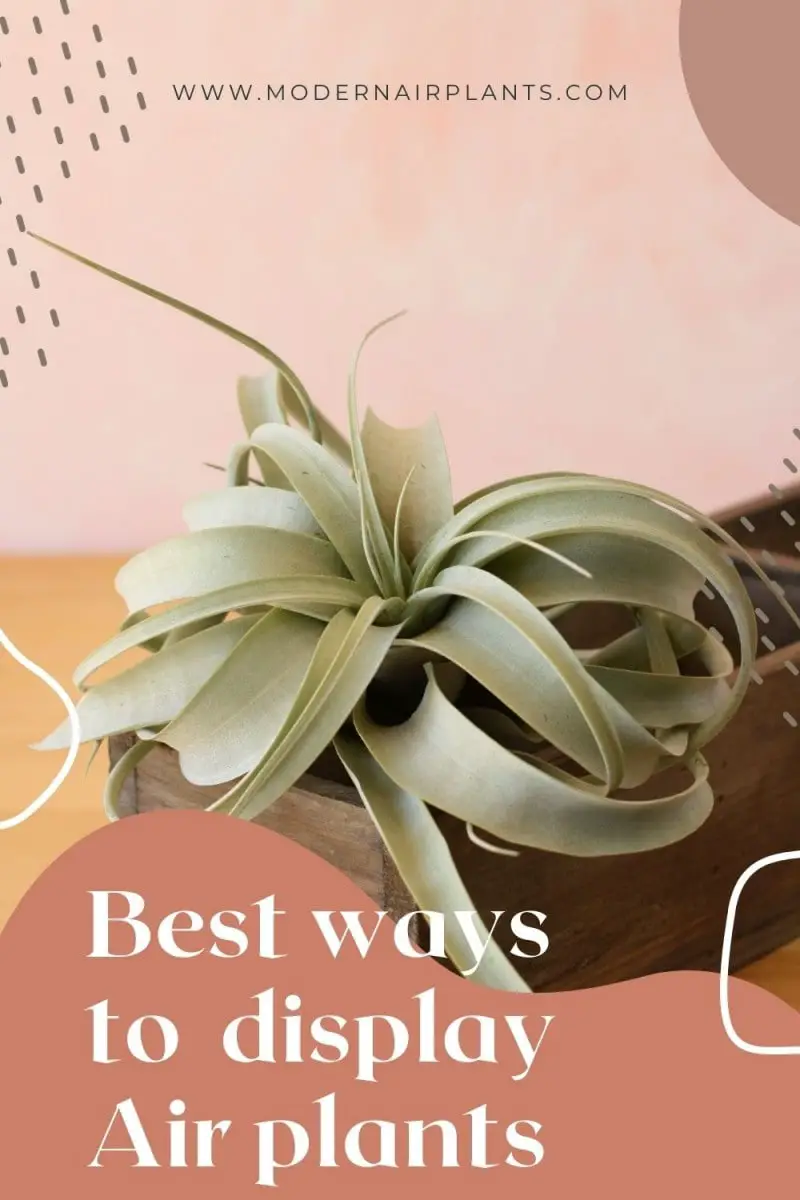
What Are Air Plants?
Tillandsia, or air plant, gets its name because it relies on air to survive. Several air plant species exist with different shapes, colors, and textures. Their main similarity is that none of them need soil as the primary food source.
Air plants come from South America and Mexico. They filter the air while growing, and if they’re happy with their environment, they bloom flowers. The flowers will dry off eventually, which is when you should cut them off. This way, your beautiful air plant can grow more of them.
Some varieties, like the spider plant, have typical terrestrial root systems. Still, even these species don’t rely on their roots for absorbing all the nutrients they need.
A family of air plants called epiphytes only use their roots to attach themselves to other plants, tree branches, trunks, rocks, or cliffs. They get their food from the moisture in the surrounding air or rainwater. They’ve developed pores on their leaves that can absorb nutrition.
Types of Air Plants
There are many varieties of air plants to name, but to decide where to place your air plant, you should be able to distinguish these two types from each other:
- Xeric: Xeric air plants come from drier climates where they get less rain and more sunlight. They’ve evolved to collect as much water as possible when it rains and store it for long dry periods. You can tell them apart by looking at their fuzzy and feathery leaves, which look like they’re coated with a layer of dust. They mostly have gray and white colors.
- Mesic: These air plants are originally from shaded, humid areas and rainforests. They get plenty of rain and can’t tolerate harsh sunlight. Mesic varieties have glossy and smooth leaves, which gives them less protection against the sun and makes them prone to drying out.
Knowing your air plant type can help you understand how to take care of it, and therefore where you can place it in the house.
Things to Consider When Taking Care of Air Plants
Light
All air plant varieties need a certain amount of daily sunlight or artificial light to thrive. Depending on their type, you can find an appropriate place for them in your house.
Mesic varieties with green leaves can happily live in bright places and spots that don’t get much light. Xeric air plants need to be in more bright locations.
However, none of the air plant types can tolerate long hours of direct sunlight. They grow on trees and rocks in dense jungles in the wild, where the tree leaves won’t let the sun hit them directly. Also, they can’t grow healthy in dimly lit rooms.
You can put both Mesic and Xeric types within one to three feet of east, west, or south-facing windows. If you’re using artificial light for your plants, place them within the range of 1–2 feet from the source.
Be careful with direct sun rays if your air plant is behind a glass. The glass creates a magnifying effect, which puts your plant in extremely high temperatures.
Temperature
Air plants come from warm areas. Whether the environment is dry or humid, you shouldn’t let the temperature drop below 45° F (7° C), where your plants will start to rot and die. The best temperature range you can provide is between 60° F (15° C) and 80° F (26° C). Don’t put your air plants close to an air conditioner vent, a fireplace, or near a window in the cold winters.
Water
The way you choose to water your air plant depends on where and how you display them. How much you should water each plant depends on their types and the humidity of the area you live in.
Water your plants in the morning so that the water evaporates from their leaves throughout the day. Both rain and tap water can work, as long as they’re at room temperature. Don’t use commercial water softeners that replace calcium and magnesium ions with sodium chloride for your air plants, as the salt will damage them.
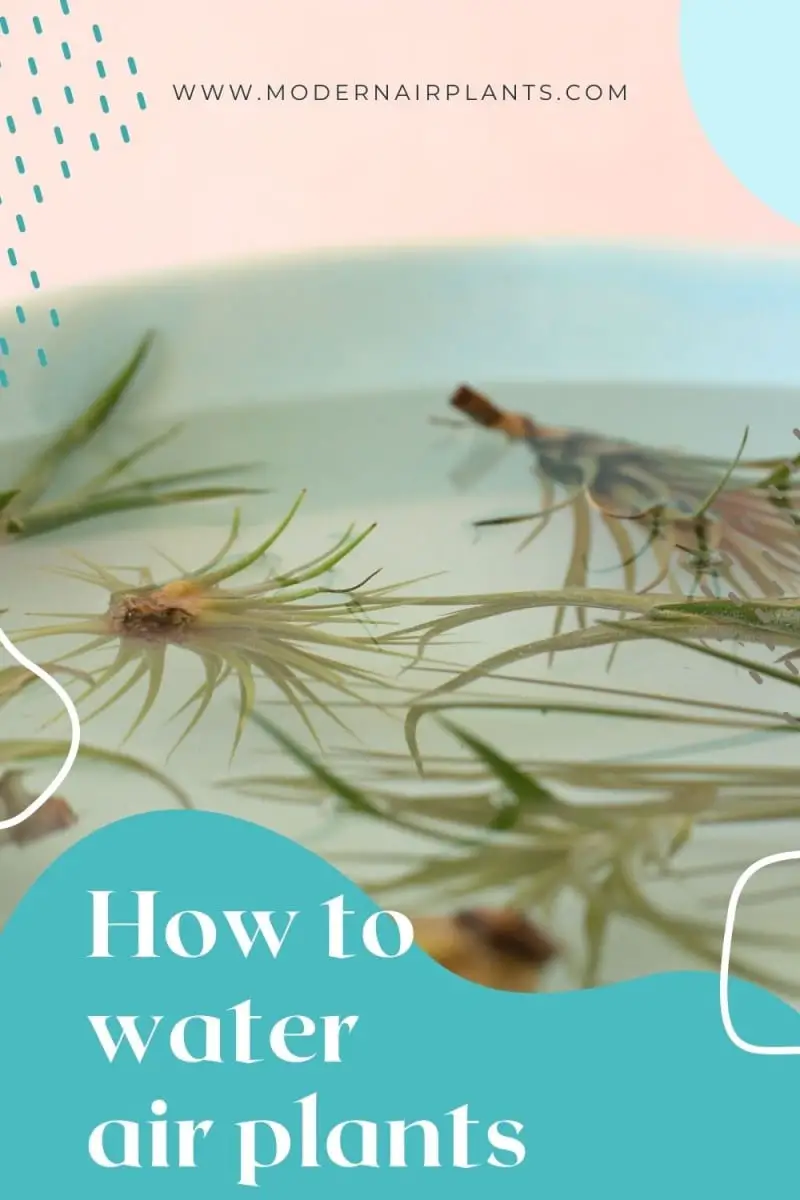
Misting
If you can’t move your plants, your only choice is to mist them with a spray bottle. All air plant species can be misted, but Xerics prefer it, as they don’t need much water.
Depending on the type, you need to mist the plant every two or three days. In sunny weather or dry winters, mist it more often. Try to get the water to all the leaves and wet the plant thoroughly.
Dunking
For Mesic air plants with thick green leaves, dunking can be a good choice because they need more water. This approach works better than misting for plants with dense or curly leaves because the water can get to all their parts. You can either put them under running water or dip them in a bowl of water for a couple of seconds.
Soaking
Some believe that dunking isn’t enough, and you should soak the plant in water for five minutes to half an hour.
Whichever method you choose, be sure to let the air plant dry completely before transferring it. Remaining wet for an extended period will cause rotting, especially if the temperature drops during the night and the moisture around the plant gets cold. Don’t place your plant on moss when it’s still wet because moss will absorb moisture and stay wet.
Shake the plant to get rid of excess water, or put it upside down on a towel. Take special care of plants with bulbous bases, where water can collect and cause rotting.
Using Fertilizer
To have healthy and robust air plants, you need fertilizers. Water-soluble orchid, cactus, or bromeliad fertilizers will work just fine for all air plants. Air plants can’t use urea nitrogen, and these fertilizers don’t contain it.
Remember to dilute the mix with water as instructed on the package. Either fill a spray bottle with the combination and mist your plant or dunk the air plant into the mixture.
You shouldn’t use too much fertilizer in every round, as it can burn your plant. It’s enough to feed your plant every month or two.
Stay away from fertilizers that contain copper, zinc, or boron, as they’re all highly toxic to air plants.
Removing Pests
Unless you keep your air plants next to your other plants or in the garden, they’ll probably be pest-free. Occasionally, mealy bugs, scales, or insect mites can infest your plant and feed on its juices. You’ll see the leaves covered with a cotton-like substance or tiny insect eggs.
Try to flush the pests off the leaves first. You can also soak the whole plant inside water for a while until the pests suffocate. If this doesn’t work, damp a piece of cloth with some rubbing alcohol and wipe the leaves with it.
Using insecticides is also an option, but be careful with the ones containing soap, as it can block the plant’s pores.
What Can You Use to Secure an Air Plant?
Roots
Air plants use their roots to anchor themselves to trees and rocks in the wild. They can do the same with any object you choose, but it’ll take some time. Be patient and don’t move them until they attach themselves to the object. Although you can trim off their roots if you want to detach them from the object in the future, it’s best to make sure you really want them there before letting the roots grow.
Wire
Using a wire is the most efficient way to attach an air plant to any object, as you can easily remove the plant and relocate it. Make sure the wire doesn’t contain copper since it’s toxic to air plants. It’s best to use wires with some kind of a coating to prevent rusting when you water your air plant.
Loop the wire through the bottom leaves and then wrap it around the plant’s base before securing it in the ideal location.
Fishing Line
You can use fishing line the same way as wires. They’re invisible, so they’ll add to the beauty of your decoration. Just pass the line through the leaves and secure it with a knot around the base.
Fishing lines are also great for hanging the air plants from the ceiling or an object.
U Bolts
U bolts can be an easy choice if you want to attach your air plant to a piece of wood. After installing them, just place the air plant inside the hole and remove it for watering any time you want. Ensure the U bolt isn’t made of copper. An iron U bolt should have a coating so rust can’t be formed, as it can also damage your air plant.
Glue
This method is the most permanent option. You can’t relocate your plant if you glue it to the object you want.
The best glue for this project is the floral adhesive, as it doesn’t hurt the plant and is also waterproof.
You can use hot glue guns, too, but they won’t last long because of constant watering. Let the glue cool down as much as you can before sticking the plant. Don’t get the glue on the leaves, and just dab the glue on the base. The leaves will eventually shed, and you’ll have to go through this process all over again.
Never use super glue because it can hurt air plants.
Now let’s discuss the best places to put air plants and display them.
Terrariums
Glass terrariums are a popular choice for housing air plants. They come in many shapes and sizes. Some have flat bottoms, which makes them perfect for shelves, tables, and stands.
You can decorate your terrariums in different ways. For example, fill the bottom with decorative sand or gravel, and put different-sized air plants inside along with moss, shells, driftwood, or rocks to create a natural landscape.
However, terrariums don’t allow much air to flow through, making things hard for the plants. After all, they’re “air” plants and need to grow in the open air. The terrariums with wider openings are more appropriate.
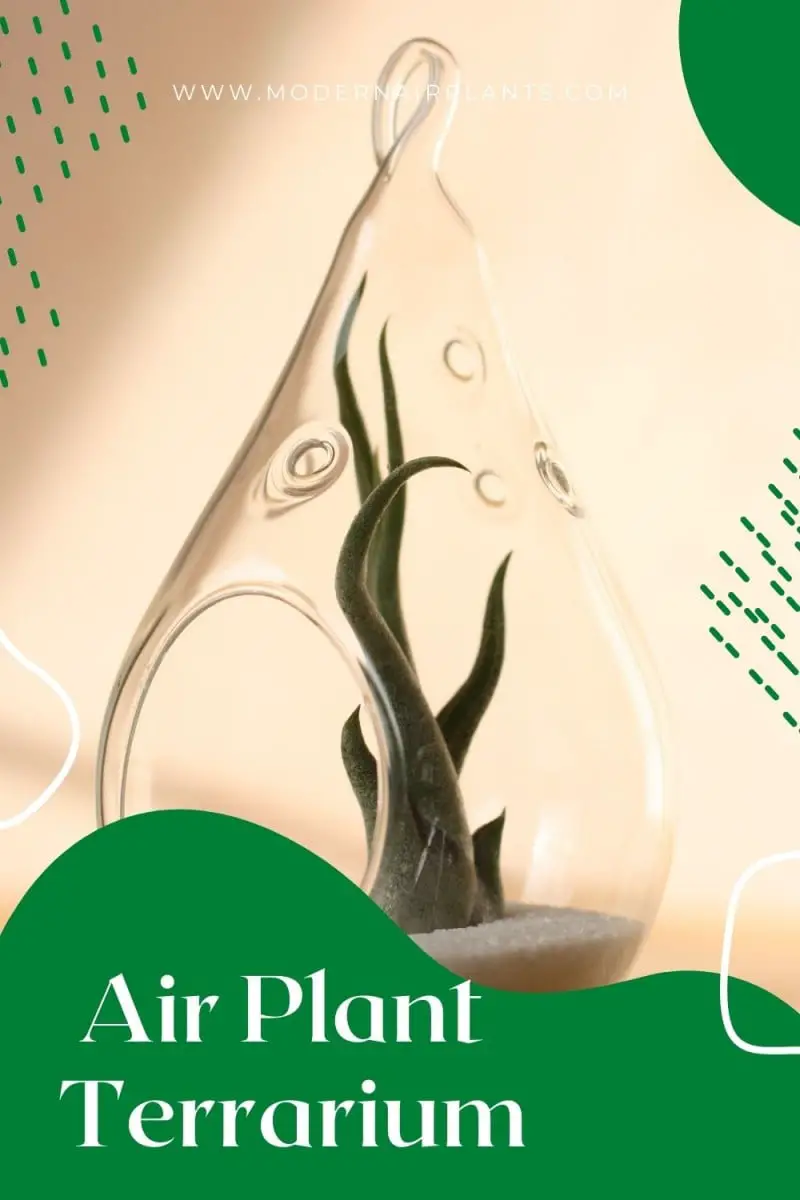
Pots and Stands
You can simply place your air plants in regular pots that come in various colors, shapes, and materials. Terracotta, ceramic, wood, concrete, and resin pots can all work well. Air plants just won’t require any soil, and you can remove them whenever. Choose a large enough pot for each air plant, in a way that gives it proper air circulation, or else the base of the plant will rot.
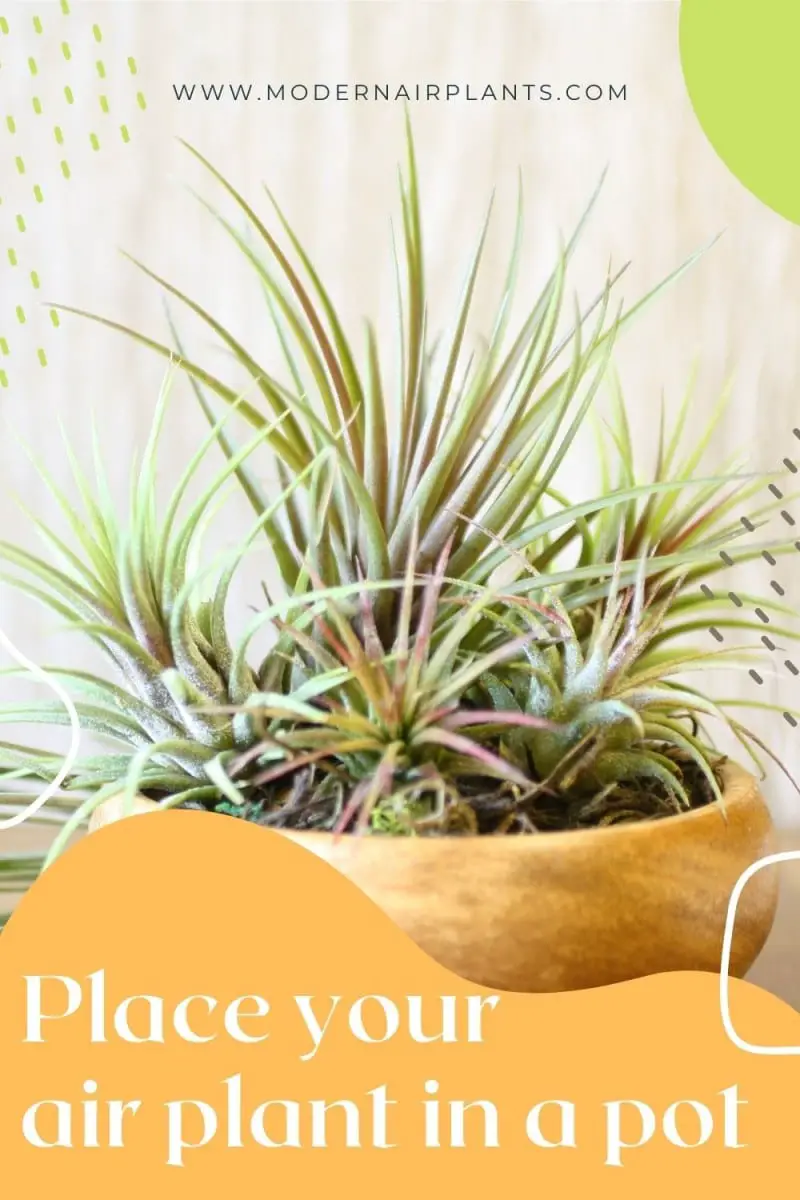
Hanging and Vertical Gardens
Different hanging decorations are great ways to display your air plants. You can use something as simple as a wire mesh and place your air plant inside the hole. You can hang wood or plastic picture frames and put the plant inside. Some planting pots come with holders that you can hang.
Macramé holders will give your house a beautiful look. Lastly, brass geometrical holders have become widely popular. They’re also known as “himmeli,” and they have many different designs that can create an aesthetic look for any room.
Air Plant Frame
This method is a frame with a mesh installed inside. You can stick multiple air plants inside the holes and create a live painting of nature. Make sure the mesh wires have a coating to prevent them from rusting. You can use spray paint for covering the mesh. You’ll probably need to secure the plants using wire or fishing line if you want to hang the frame on the wall.
Shells
Seashells and urchins make cute homes for tiny air plants. They have small holes to stick the plants in. You can also glue the air plants inside urchins, turn them upside down, hang them using fish lines, and you’ll have yourself some cute floating jellyfish!
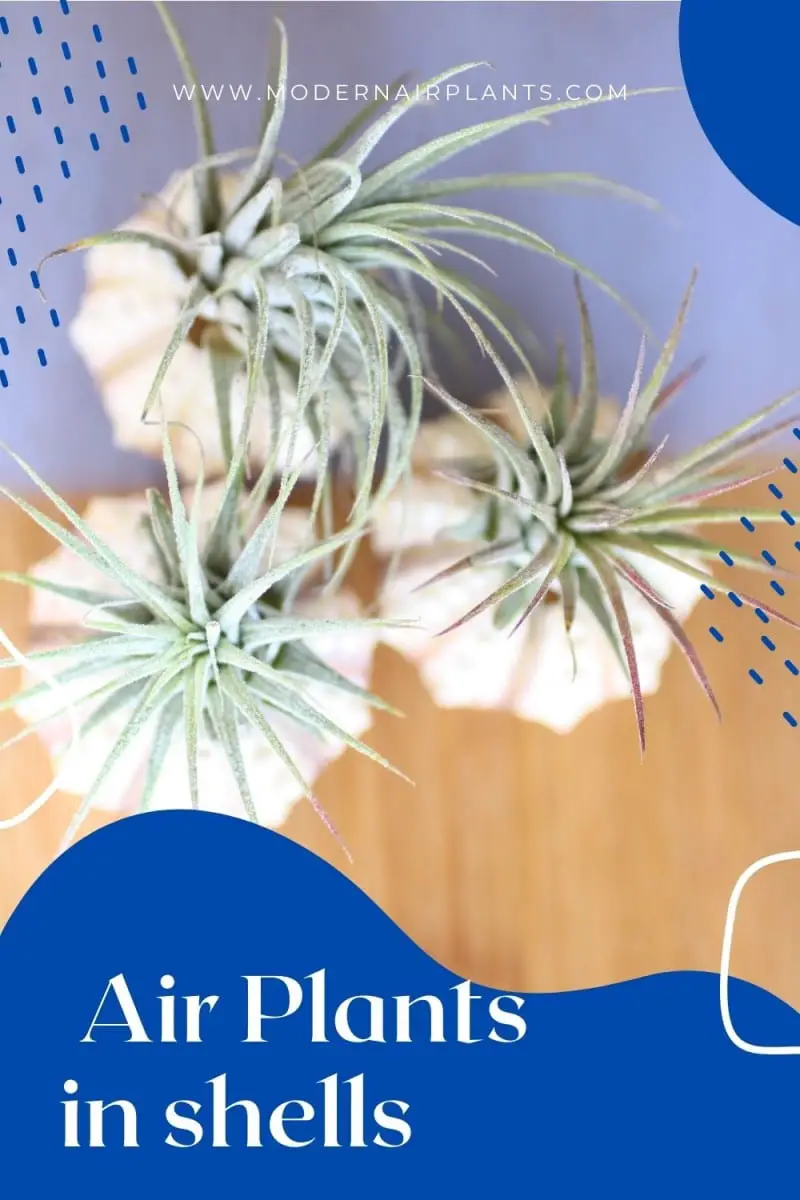
Wood
Combining air plants with wood can bring nature into your house. You can use wooden pots, frames, or even natural pieces of driftwood. Either let the plant attach itself to the wood, or drill holes inside it and place or glue the air plants. You could also attach the air plants to simple wooden boards using wire, fishing line, glue, or U bolts, and then hang them on the wall.
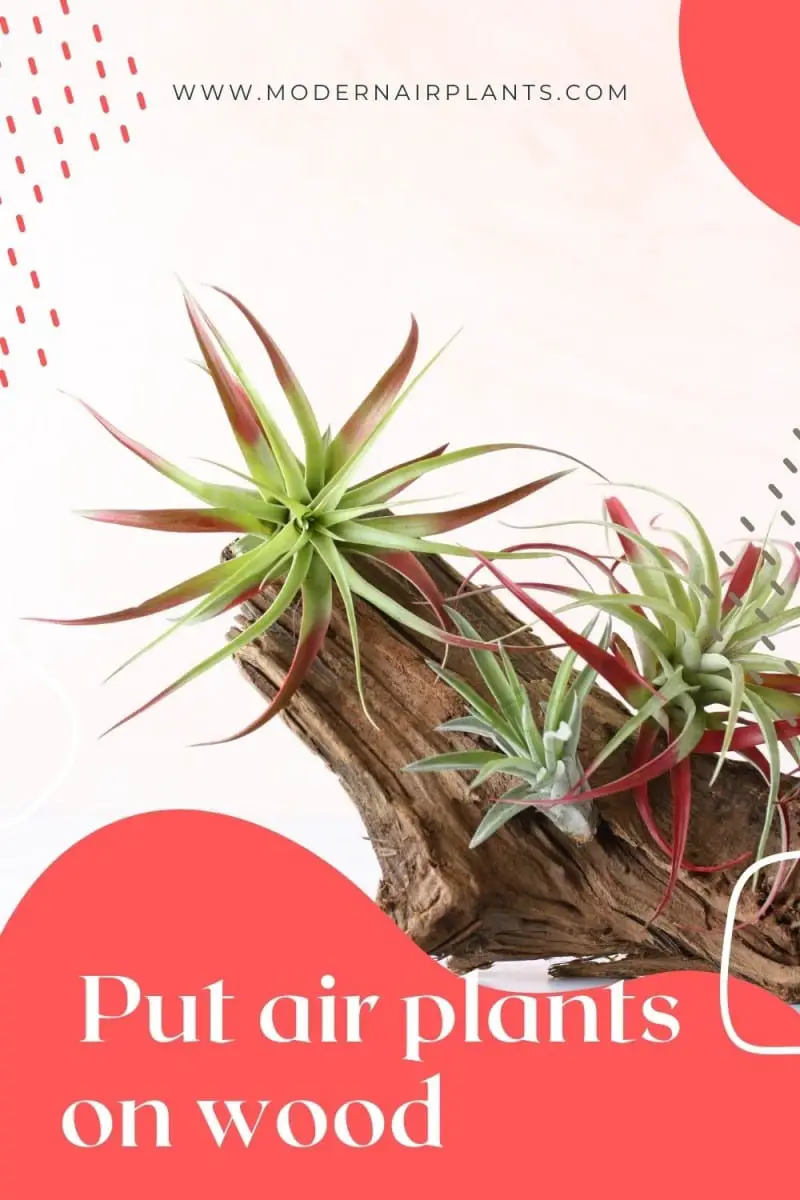
Other Ideas to Display Air Plants
Here are some other ideas to consider:
- Cork bark: Cutting cork bark is pretty easy, and you can create beautiful looks such as frames, stands, or other containers using cork bark.
- Wreath: Decorating wreaths with air plants is a popular option. You can attach them to wooden or plastic wreaths using wire or glue. Just be sure to water them enough when it’s hot, and bring them inside in the winter.
- Your existing garden: Placing air plants in between the other plants can make your garden more beautiful. They can have their pots or share pots with other plants.
- Household objects: Place air plants in any household object, and they’ll be happy as ever! Arrange them inside a basket, a fishbowl, a decorative dish, vintage cups, or even glass jars.
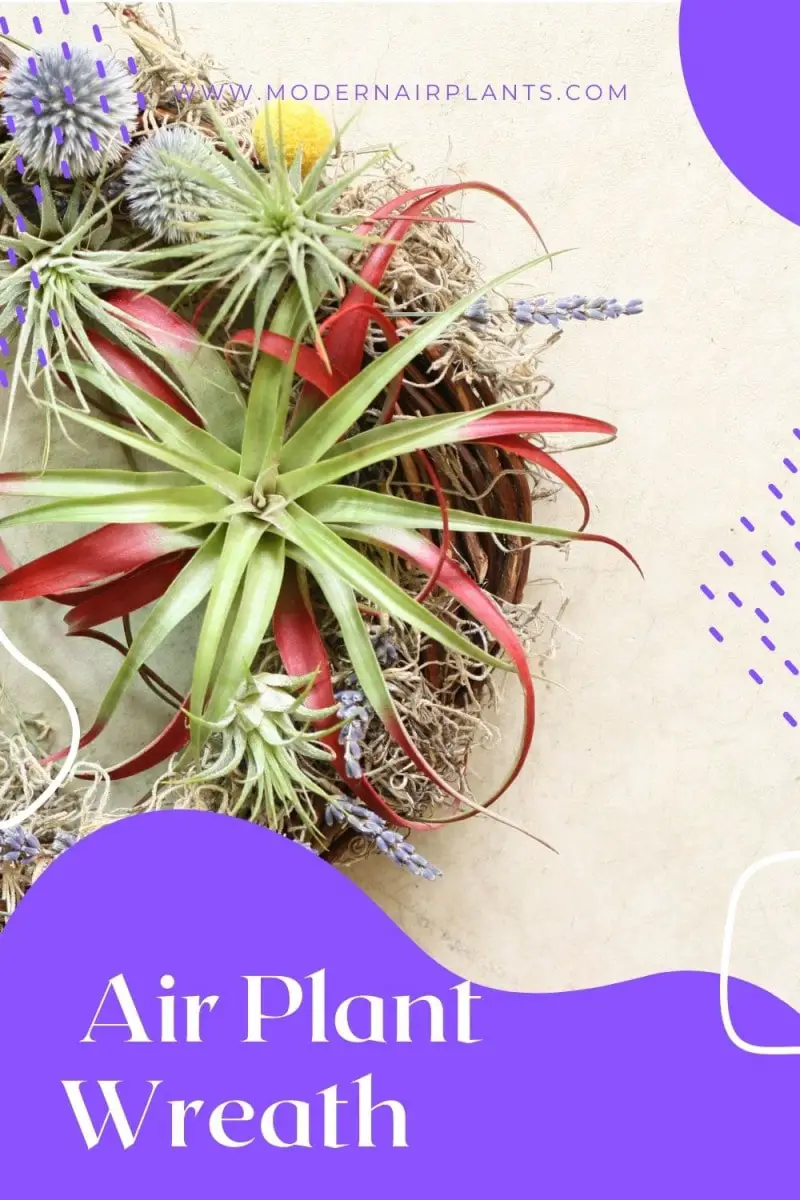
Tips for Keeping Air Plants
You can keep air plants outside, as long as you provide a shade to protect them from too much direct sunlight. If you live in areas where the temperature drops during the winter, you’ll have to bring the air plants inside, or else they’ll rot. In the hot days of summer, you should water them more frequently.
Air plants don’t have any use for their roots, other than attaching to objects. Unless you’ve decided to let your plant anchor itself to something, you can just trim the roots off, so they won’t get in the way of relocating and watering.
Other than copper fertilizers and copper wires, stay away from any pot, bowl, or container that contains copper when handling air plants because they’re highly allergic.
Frequently Asked Questions
-
- Do air plants get bigger? Yes, air plants will grow and get bigger with time. They grow more slowly when they’re young but grow a little faster as they mature. If you grow air plants from seeds, it’ll take a long time for them to get big, but they’ll be stronger and more healthy.
- How long can air plants go without water? Depending on the species, air plants can go for one to two weeks without water. Xeric varieties can last longer because they come from drier climates. If you haven’t watered your air plant for a while, it’s best to bathe it by soaking it in water for 5–30 minutes.
- What does an overwatered air plant look like? Yellowish leaves, mushy roots, bases turning dark, and leaves falling off are all signs of an overwatered air plant. Water it less frequently, hang it upside down after watering, and water it in the morning to let the sun dry the moisture during the day.
Conclusion
You have multiple options for decorating your living room, office, or even bathroom with air plants. They’re easy to take care of, and they can adapt themselves to various environments. They’ll be happy as long as you keep them away from direct sunlight and low temperatures. Also, make sure you water them regularly and feed them with proper fertilizers every couple of months.
Sources
- Contemporist: 12 Elegant Ways To Bring Air Plants Into Your Home
- Gardeners: How to Grow Air Plants, Tillandsia
- Country Living: Air Plants: The Complete Guide On How to Care for and Display Air Plants and Where to Buy These Low-Maintenance Houseplants
- Balcony Garden: 51 Most Amazing Air Plant Display Ideas
- Elle Decor: 14 Creative Air Plant Display Ideas for the Fashionably Green-thumbed
- Better Homes and Gardeners: Air Plant Display Ideas
- Air Plant Supply: 5 Ways to Display Your Air Plants
- Sunset: Care for Air Plants: 6 Tricks to Keep Them Alive
- Air Plant Design Studio: Mounting Air Plants 101
- Youtube: Air Plant Display Ideas | Tillandsia Gardening Tips | Indoor Gardening
- Youtube: Air Plants Display & Care
- Youtube: Hanging Air Plants: 10 Easy Ways to Hang Tillandsias/JoyUsgarden

